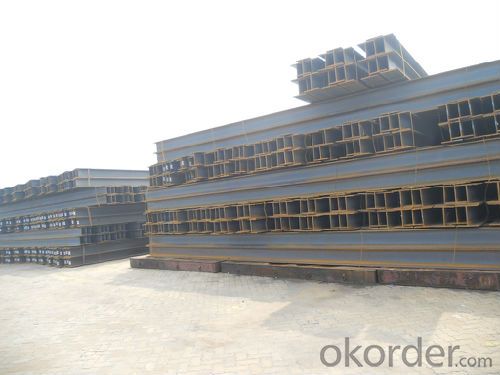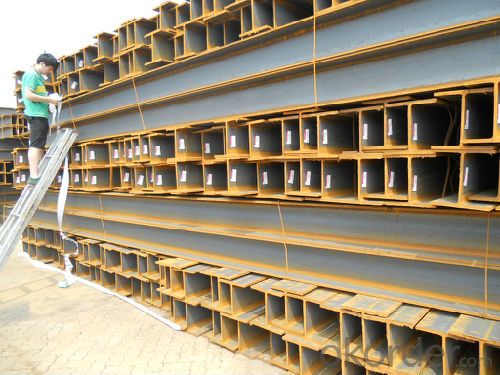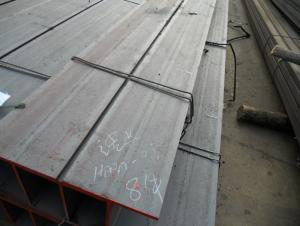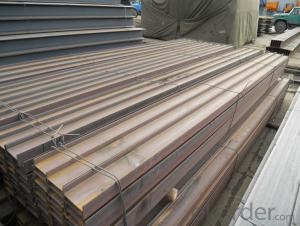JIS Standard Hot Rolled Steel H Beams of Steel Grade SS400
- Loading Port:
- Shanghai
- Payment Terms:
- TT or LC
- Min Order Qty:
- 25 m.t.
- Supply Capability:
- 200000 m.t./month
OKorder Service Pledge
OKorder Financial Service
You Might Also Like
Product Description:
OKorder is offering JIS Standard Hot Rolled Steel H Beams of Steel Grade SS400 at great prices with worldwide shipping. Our supplier is a world-class manufacturer of steel, with our products utilized the world over. OKorder annually supplies products to European, North American and Asian markets. We provide quotations within 24 hours of receiving an inquiry and guarantee competitive prices.
Product Applications:
JIS Standard Hot Rolled Steel H Beams of Steel Grade SS400 are ideal for structural applications and are widely used in the construction of buildings and bridges, and the manufacturing, petrochemical, and transportation industries. Commercial building structure ;Pre-engineered buildings; Machinery support structure; Prefabricated structure; Medium scale bridges; Ship-building structure. etc.
Product Advantages:
OKorder's JIS Standard Hot Rolled Steel H Beams of Steel Grade SS400 are durable, strong, and resist corrosion.
Main Product Features:
· Premium quality
· Prompt delivery & seaworthy packing (30 days after receiving deposit)
· Corrosion resistance
· Can be recycled and reused
· Mill test certification
· Professional Service
· Competitive pricing
Specifications of JIS Standard Hot Rolled Steel H Beams of Steel Grade SS400
1. Standard: JIS G3101
2. Grade: SS400 or Equivalent
3. Length: 6m,10m, 12m as following table
4. Invoicing on theoretical weight or actual weight as customer request
5.Payment: TT or L/C
6. Sizes:
SIZE(mm) | DIMENSION(kg/m) |
100*100 | 16.9 |
125*125 | 23.6 |
150*75 | 14 |
150*150 | 31.1 |
148*100 | 20.7 |
198*99 | 17.8 |
200*100 | 20.9 |
248*124 | 25.1 |
250*125 | 29 |
300*150 | 36.7 |
298*149 | 32 |
200*200 | 49.9 |
294*200 | 55.8 |
346*174 | 41.2 |
350*175 | 49.4 |
244*175 | 43.6 |
175*175 | 40.4 |
294*200 | 55.8 |
298*201 | 64.4 |
346*174 | 41.2 |
350*175 | 49.4 |
400*200 | 65.4 |
396*199 | 56.1 |
450*200 | 74.9 |
446*199 | 65.1 |
340*250 | 78.1 |
500*200 | 88.1 |
300*150 | 36.7 |
Packaging & Delivery of JIS Standard Hot Rolled Steel H Beams of Steel Grade SS400
1. Packing: it is nude packed in bundles by steel wire rod
2. Bundle weight: not more than 3.5MT for bulk vessel; less than 3 MT for container load
3. Marks:
Color marking: There will be color marking on both end of the bundle for the cargo delivered by bulk vessel. That makes it easily to distinguish at the destination port.
Tag mark: there will be tag mark tied up on the bundles. The information usually including supplier logo and name, product name, made in China, shipping marks and other information request by the customer.
If loading by container the marking is not needed, but we will prepare it as customer request.
4. Transportation: the goods are delivered by truck from mill to loading port, the maximum quantity can be loaded is around 40MTs by each truck. If the order quantity cannot reach the full truck loaded, the transportation cost per ton will be little higher than full load.
5. Delivered by container or bulk vessel
Production flow of JIS Standard Hot Rolled Steel H Beams of Steel Grade SS400
Material prepare (billet) —heat up—rough rolling—precision rolling—cooling—packing—storage and transportation


FAQ:
Q1: What is the normal tolerance of JIS Standard Hot Rolled Steel H Beams of Steel Grade SS400?
A1: Normally 3%-5%, but we can also produce the goods according to the customers' requests.
Q2: Can fit in the containers of 20fts the steel beams of 6M?
A2: No proble, we can put them into the containers in the form sideling.
Q3: The products are invoicing on theoritical weight or on actual weight?
A3: We can do it in both manners, according to the customers' request.
- Q:Can steel H-beams be used in sports stadiums and arenas?
- Yes, steel H-beams can be used in sports stadiums and arenas. They are commonly used in construction projects due to their strength and versatility. H-beams provide structural support and can withstand heavy loads, making them suitable for large-scale buildings like sports stadiums and arenas.
- Q:What are the fire resistance ratings for steel H-beams?
- The fire resistance ratings for steel H-beams depend on various factors such as the dimensions of the beam, the type of fire protection applied, and the specific building codes and regulations in place. Generally, steel H-beams have inherent fire-resistant properties due to their high melting point and structural stability. However, to enhance their fire resistance, additional fireproofing materials such as intumescent coatings or fire-resistant insulations can be applied. These measures can significantly increase the fire resistance ratings of steel H-beams, allowing them to withstand fire exposure for extended periods, typically ranging from 30 minutes to several hours.
- Q:What are the different design codes and standards applicable to steel H-beams?
- Steel H-beams are subject to various design codes and standards that guarantee their structural integrity and safe usage in different applications. Notable design codes and standards include: 1. The American Institute of Steel Construction (AISC) offers design guidelines and specifications for steel structures, including H-beams. Widely used in the United States, the AISC Manual of Steel Construction provides comprehensive information on the design, fabrication, and erection of steel structures. 2. In Europe, the European Norms (EN), particularly EN 1993-1-1 (Eurocode 3), present design rules for steel structures. These norms consider factors such as material properties, loadings, and stability requirements when designing H-beams and their connections. 3. British Standards (BS), such as BS 5950-1 and BS EN 1993-1-1, provide design recommendations for steel structures in the United Kingdom. These standards encompass the design of H-beams, including member capacities, buckling resistance, and connection design. 4. The Canadian Standards Association (CSA) has CSA S16, the Canadian standard for the design of steel structures. This standard addresses the design and analysis of H-beams, covering topics like member design, stability considerations, and seismic design requirements. 5. In Australia, the Australian Standards (AS), particularly AS 4100, provide guidelines for the design and construction of steel structures. These standards encompass the design of H-beams, including loadings, material properties, and construction details. 6. The International Organization for Standardization (ISO) has ISO 14346, an international standard specifying the requirements for hot-rolled H-beams with narrow flanges and wide flanges. It provides dimensional and structural specifications for H-beams manufactured worldwide. Engineers and designers involved in the design and construction of steel H-beams rely on these design codes and standards as vital references. By adhering to these guidelines, they can ensure that H-beams meet industry-accepted practices and regulations, guaranteeing their structural safety, integrity, and compliance.
- Q:Are steel H-beams resistant to electrical conductivity?
- Yes, steel H-beams are generally resistant to electrical conductivity. Steel is a poor conductor of electricity, so H-beams made from steel do not easily allow the flow of electrical current.
- Q:What are the safety considerations when working with steel H-beams?
- Some safety considerations when working with steel H-beams include: 1. Proper lifting techniques: H-beams are heavy and require specialized equipment, such as cranes or forklifts, for lifting and moving. It is essential to follow proper lifting techniques to avoid injuries or accidents. 2. PPE (Personal Protective Equipment): Workers should wear appropriate PPE, including steel-toed boots, gloves, and helmets, to protect themselves from potential hazards like falling objects or sharp edges. 3. Secure storage and handling: H-beams should be stored and handled in a secure manner to prevent them from falling or causing accidents. Proper storage racks or supports should be used, and workers should avoid stacking beams too high or unevenly. 4. Inspection and maintenance: Regular inspection of H-beams is necessary to identify any signs of wear, deformation, or damage. Damaged beams should be immediately replaced to avoid potential structural failures or accidents. 5. Safe work environment: It is crucial to maintain a clean and organized work area to minimize tripping hazards. Workers should also be trained to recognize and avoid potential pinch points or other dangers associated with working around H-beams. 6. Communication and teamwork: Effective communication between workers is essential to ensure everyone is aware of their surroundings and the tasks being performed. Teamwork is crucial when maneuvering heavy H-beams to maintain balance and prevent accidents. By following these safety considerations, the risk of accidents or injuries can be significantly reduced, creating a safer working environment for all involved.
- Q:How do steel H-beams contribute to the overall sustainability of a construction project?
- Steel H-beams contribute to the overall sustainability of a construction project in several ways. Firstly, steel is a highly durable and long-lasting material, which means that H-beams made from steel can withstand the test of time and require minimal maintenance or replacement over the lifespan of the building. This reduces the need for additional resources and materials, promoting sustainability. Secondly, steel H-beams have a high strength-to-weight ratio, allowing for efficient and optimized structural designs. This means that less steel is needed to support the same load compared to other materials, resulting in reduced material consumption and lower carbon emissions associated with production and transportation. Additionally, steel is a highly recyclable material, and H-beams can be easily dismantled and recycled at the end of their life cycle. This reduces the environmental impact of construction projects by minimizing waste and conserving resources. Overall, the use of steel H-beams in construction projects contributes to sustainability by promoting durability, optimizing material usage, and facilitating recycling, thereby minimizing the environmental footprint of the project.
- Q:What are the different types of steel H-beams available?
- There exists a variety of steel H-beams, each possessing distinctive characteristics and applications. 1. Standard H-beams, widely used and versatile, come in various sizes and dimensions. They find application in the construction industry, providing structural support for buildings and bridges. 2. Wide flange beams, also known as W-beams, possess broader flanges compared to standard H-beams. This design enhances stability and support, rendering them suitable for heavy-duty applications like high-rise buildings, industrial structures, and platforms. 3. I-beams, while not technically H-beams, share a similar shape and are often grouped together. I-beams have a narrower profile, with a flange on one side and a web on the other. They are frequently employed in steel construction projects, including beams, columns, and joists. 4. Tapered H-beams feature a tapered shape, with diminishing flange and web thickness from top to bottom. They serve applications where weight reduction is crucial, such as aerospace industries or specific architectural designs. 5. Light H-beams are characterized by their lightweight design and find primary use in weight-sensitive applications like the automotive industry or lightweight structures. They offer a high strength-to-weight ratio and are available in various sizes. 6. Stainless steel H-beams are crafted from stainless steel, providing superior corrosion resistance and durability. They are commonly used in environments prone to moisture or chemical exposure, such as coastal areas or chemical processing plants. It is worth noting that the availability of these steel H-beam types may vary depending on the supplier or manufacturer. Therefore, it is advisable to consult a steel supplier or structural engineer to determine the most suitable H-beam type for your specific application.
- Q:What are the different dimensions of steel H-beams?
- Steel H-beams offer a range of dimensions, with their most common sizes determined by their height, width, and weight per foot. H-beams typically vary in height from 4 inches to 18 inches, while their widths range from 5 inches to 12 inches. The weight per foot of H-beams varies between 5.7 pounds and 121 pounds, depending on the size. Moreover, the specific dimensions of the H-beam also influence the flange thickness and web thickness. These diverse dimensions provide structural design flexibility and enable the utilization of steel H-beams in a wide array of applications, such as constructing buildings and bridges, as well as supporting heavy loads in industrial settings.
- Q:Can steel H-beams be used for supporting theater stages or platforms?
- Yes, steel H-beams can be used for supporting theater stages or platforms. H-beams are known for their strength and durability, making them a popular choice for structural applications. They provide excellent load-bearing capabilities and can support heavy loads, making them suitable for supporting theater stages or platforms where heavy equipment, props, and performers may be present. Additionally, steel H-beams can be customized to meet specific design and size requirements, ensuring the structural integrity and safety of the theater stage or platform.
- Q:How do steel H-beams contribute to indoor air quality in buildings?
- Steel H-beams do not directly contribute to indoor air quality in buildings. They are structural members used to support the weight of the building, primarily for load-bearing purposes. However, the materials used in construction, such as paints, adhesives, and insulation, can impact indoor air quality. It is important to ensure that these materials are selected and installed properly to maintain good indoor air quality.
1. Manufacturer Overview |
|
|---|---|
| Location | |
| Year Established | |
| Annual Output Value | |
| Main Markets | |
| Company Certifications | |
2. Manufacturer Certificates |
|
|---|---|
| a) Certification Name | |
| Range | |
| Reference | |
| Validity Period | |
3. Manufacturer Capability |
|
|---|---|
| a)Trade Capacity | |
| Nearest Port | |
| Export Percentage | |
| No.of Employees in Trade Department | |
| Language Spoken: | |
| b)Factory Information | |
| Factory Size: | |
| No. of Production Lines | |
| Contract Manufacturing | |
| Product Price Range | |
Send your message to us
JIS Standard Hot Rolled Steel H Beams of Steel Grade SS400
- Loading Port:
- Shanghai
- Payment Terms:
- TT or LC
- Min Order Qty:
- 25 m.t.
- Supply Capability:
- 200000 m.t./month
OKorder Service Pledge
OKorder Financial Service
Similar products
New products
Hot products
Related keywords



























